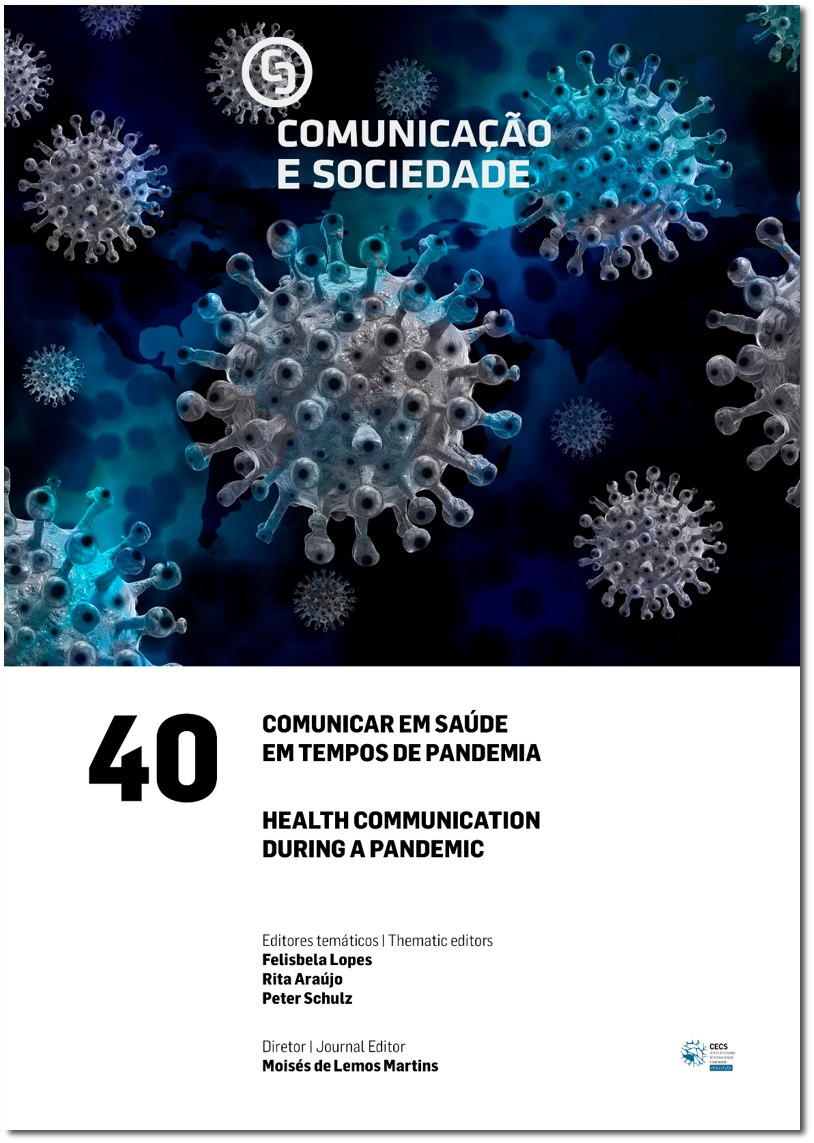The Controversy in Media Health Coverage: The Stayaway Covid Application and Information Sources
DOI:
https://doi.org/10.17231/comsoc.40(2021).3254Keywords:
pandemic, media, sources of information, controversy, health journalismAbstract
Presented as an essential tool to stop the covid-19 pandemic, the Stayaway Covid app has remained at the scene of the national media landscape since it was mentioned for the first time, having generated around 1,400 news in 2020. This remarkable volume of news coverage reflects the potential relevance of this technology during a pandemic and the controversy among the public and the media. To contribute to the understanding of the news coverage of the application, we analysed the sources of a sample of 182 press, radio and television news pieces associated with Stayaway Covid, distinguishing those that focus on privacy and obligatoriness controversies from those that do not. In this case of public health controversy, the results show that experts did not take the lead, with politicians having a more prominent role in fueling the controversy, especially concerning the intention to make the application mandatory.
Downloads
References
Cabrera, A., Martins, C., & Cunha, I. F. (2020). A cobertura televisiva da pandemia de covid-19 em Portugal: Um estudo exploratório. Media & Jornalismo, 20(37), 185–204. https://doi.org/10.14195/2183-5462_37_10
Comissão Europeia. (s.d.). Aplicações móveis de rastreio de contactos nos Estados-Membros da EU. Retirado a 6 de fevereiro, 2021, de https://ec.europa.eu/info/live-work-travel-eu/coronavirus-response/travel-during-coronavirus-pandemic/mobile-contact-tracing-apps-eu-member-states_pt
Gaspar, A. S. (2016). Comentário [Comentário no artigo Breast cancer screening in women aged 40 to 49 years: Do the benefits outweigh the harms?]. Revista Portuguesa de Medicina Geral e Familiar, 32,78–79. http://www.scielo.mec.pt/pdf/rpmgf/v32n1/v32n1a13.pdf
Estatuto do Jornalista. Lei n.º 1/1999, Diário da República n.º 10/1999, Série I-A de 1999-01-13 (1999). https://dre.pt/web/guest/legislacao-consolidada/-/lc/58785580/202101061416/58809843/diploma/indice
Hivon, M., Lehoux, P., Denis J. L., & Rock, M. (2010). Marginal voices in the media coverage of controversial health interventions: how do they contribute to the public understanding of science? Public Understanding of Science, 19(1), 34–51. https://doi.org/10.1177%2F0963662508088668
Lopes, F. (2016). Uma proposta de um modelo taxonómico para a classificação de fontes de informação. Observatório (OBS*) Journal, 10(4), 180–191. http://obs.obercom.pt/index.php/obs/article/view/951
Lopes, F., Marinho, S., Fernandes, L., Araújo, R., & Gomes, S. (2013). A saúde em notícia na imprensa portuguesa entre setembro de 2010 e junho 2013. In F. Lopes, T. Ruão, S. Marinho, Z. Pinto-Coelho, L. Fernandes, R. Araújo, & S. Gomes (Eds.), A saúde em notícia: Repensando práticas de comunicação (pp. 56–79). CECS. https://repositorium.sdum.uminho.pt/bitstream/1822/29800/1/Ebook_projeto_saude.pdf
Lopes, F., Ruão, T., & Marinho, S. (2010). Gripe A na imprensa portuguesa: Uma doença em notícia através de uma organizada estratégia de comunicação. Observatório (OBS*) Journal, 4(4), 140–147. http://obs.obercom.pt/index.php/obs/article/view/442
Magalhães, O., Lopes, F., & Araújo, R. (2020). Doenças oncológicas em notícia: A força da investigação médica. Observatório (OBS*) Journal, 14(3), 120–133. http://obs.obercom.pt/index.php/obs/article/view/1565/pdf
Munzert, S., Selb, P., Gohdes, A., Stoetzer, L. F., & Lowe, W. (2021). Tracking and promoting the usage of a covid-19 contact tracing app. Nature Human Behaviour, 5(1), 1–9. https://doi.org/10.1038/s41562-020-01044-x
Nagler, R. H., Fowler, E. F., & Gollust, S. E. (2015). Covering controversy: What are the implications for women’s health? Women’s Health Issues, 25(4), 318–321.https://doi.org/10.1016/j.whi.2015.04.011
Nagler, R. H., Fowler, E. F., Marino, N. M., Mentzer, K. M., & Gollust, S. E. (2019). The evolution of mammography controversy in the news media: A Content analysis of four publicized screening recommendations, 2009 to 2016. Women’s Health Issues, 29(1), 87–95. https://doi.org/10.1016/j.whi.2018.09.005
Nisbet, M. C., Brossard, D., & Kroepsch, A. (2003). Framing science: The stem cell controversy in an age of press/politics. Harvard International Journal of Press/Politics, 8(2), 36–70. https://doi.org/10.1177%2F1081180X02251047
Patil, R. R. (2011). Public health controversies: Common characteristics. Journal of global infectious diseases, 3(1), 97–98. https://doi.org/10.4103/0974-777X.77308
Pinto, M. (2000). Fontes jornalísticas: Contributos para o mapeamento do campo. Comunicação e Sociedade, 2, 277–294. https://doi.org/10.17231/comsoc.2(2000).1401
Reynolds, B., & Seeger, M. (2005). Crisis and emergency risk communication as an integrative model. Journal of Health Communication, 10, 43–55. https://doi.org/10.1080/10810730590904571
Shuchman, M., & Wilkes, M. (1997). Medical scientists and health news reporting: A case of miscommunication. Annals of Internal Medicine, 126, 976–982. https://doi.org/10.7326/0003-4819-126-12-199706150-00008
Szabo, A. (2020). Immediate and persisting effects of controversial media information on young people’s judgement of health issues. Europe’s Journal of Psychology, 16(2), 249–261. https://doi.org/10.5964/ejop.v16i2.1929
Traquina, N. (2010). [Recensão do livro Democracy and the news, de H. J. Gans]. Media & Jornalismo, 9(2), 255–257. http://fabricadesites.fcsh.unl.pt/polocicdigital/wp-content/uploads/sites/8/2017/04/17_3-recensao.pdf
Tschötschel, R., Schuck, A., & Wonneberger, A. (2020). Patterns of controversy and consensus in German, Canadian, and US online news on climate change. Global Environmental Change, 60, Artigo 101957.https://doi.org/10.1016/j.gloenvcha.2019.101957
Vaughan, E., & Timothy, T. (2009). Effective health risk communication about pandemic influenza for vulnerable populations. American Journal of Public Health, 99(S2), 324–332. https://doi.org/10.2105/AJPH.2009.162537
World Health Organization. (2020, 23 de dezembro). A year without precedent: WHO’s covid-19 response. https://www.who.int/news-room/spotlight/a-year-without-precedent-who-s-covid-19-response
Downloads
Published
How to Cite
Issue
Section
License
Copyright (c) 2021 Sandra Pinto, Eunice Oliveira, Elsa Costa e Silva

This work is licensed under a Creative Commons Attribution-NonCommercial 4.0 International License.
Authors own the copyright, providing the journal with the right of first publication. The work is licensed under a Creative Commons Attribution 4.0 International License.












